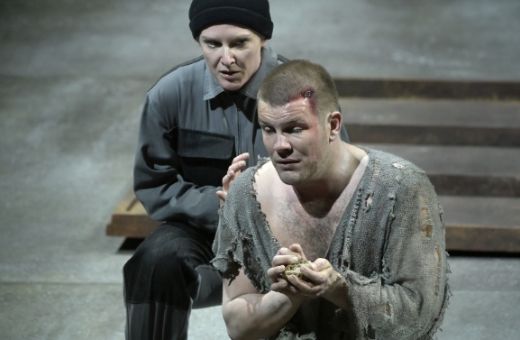For an opera, Fidelio is almost more effective in concert. For all of Beethoven’s skill in orchestral drama, many a stage director has failed to turn Fidelio into a coherently paced narrative. All the better, then, that French conductor Laurence Equilbey and her Insula Orchestra presented it in semi-staged form on tour at the Barbican, placing the emphasis firmly on the orchestra.

The direction by David Bobée was adapted from the fully-staged production the cast performed in Brussels a few days prior. The staging has been adapted to the Barbican stage, with the orchestra in the centre and making use of the choir stalls at the back. With discreet lighting and minimalist-chic costumes, the staging neither detracted nor added very much, though some moments strained credulity: for Leonore's big reveal there was no way she could have killed Pizarro, located across the stage with a knife to Florestan's throat.
Equilbey isn’t the first and certainly won’t be the last to perform Fidelio on period instruments, but her interpretation was marked by a remarkable versatility. Equilbey paces the opera wonderfully, with a Haydn-esque finesse for the domestic dramas of the first act which builds in tension and gravity throughout. After a rocky overture, her orchestra coloured the score with vivid detail, from the atmospheric groans that open the second act to the propulsive brass of the finale. One might miss the power of a full string section and the accuracy of valved horns, but the period instruments bring a refreshing warmth, lyricism, and clarity to the score.
The performance was thoughtfully cast to match Equilbey’s conception of the score. Notably, the central couple were cast lighter than usual, aided by the fact that Equilbey never let the orchestra cover the singers even in the famously unflattering acoustic of the Barbican. Sinéad Campbell-Wallace began her career as a light lyric soprano, and she retains the flexibility to navigate Beethoven’s treacherous writing – I’ve never heard anyone take the final pages of “Abscheulicher” with such ease. It’s a voice that projects beautifully, though, from a ringing upper register to a resonant chest voice. Dramatically, Campbell-Wallace captured both the character’s strength and vulnerability, bringing an uncommon complexity to the role even in a concert setting.
Similarly, tenor Stanislas de Barbeyrac has recently transitioned into more dramatic repertoire and it’s easy to see why. Despite his voice retaining its purity and freshness, it fills the Barbican with ease and, at full tilt, has gained remarkable heft. It’s not yet a fully Wagnerian voice and you could see the physical preparation required for some phrases, which comes at the expense of a fully fleshed-out characterisation. But the sensitivity he achieved in his famously difficult opening aria was worth it, including a remarkable crescendo on the first note, and this was an extremely promising role debut. On the other extreme, Sebastian Holecek brought a booming bass-baritone and broad characterization to Don Pizarro. While it’s thrilling to hear such a resonant voice in the role, Holecek fell too easily into cartoon villainy which, ironically, makes him far less menacing. Baritone Anas Séguin, though, made the most of his brief time onstage, bringing a noble presence and velvety tone to Don Fernando.
The domestic squabbles of Act 1 can be a drag, but Hélène Carpentier and Patrick Grahl brought an appealing earnestness to their parts. Carpentier’s plum-hued soprano is darker than usual for Marzelline and she brought an earthiness and melancholy to the part that made a refreshing contrast from the usual soubrette. She spun the opening of the quartet beautifully and more than held her own with Campbell-Wallace’s heroic soprano in the ensembles. As her put-upon lover Jaquino, Grahl showed an easy theatricality, bounding around the stage with puppy-dog eyes and a buoyant tenor. They were overseen by Christian Immler’s benevolent Rocco, charting the ambiguity of the character’s moral development with mellifluous tone. Best of all, though, was Equilbey’s Accentus chamber choir on glorious form. The harmonic suspensions of “O welche lust” did not fail to move, long-lined and hushed under Equilbey’s baton but pulsing with repressed angst.


